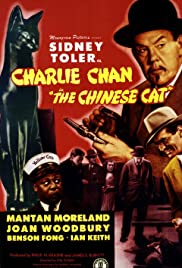
CHARLIE CHAN IN THE CHINESE CAT
US, 1944, 62 minutes, Black-and-white.
Sidney Toler, Joan Woodbury, Mantan Moreland, Benson Fong, Ian Keith.
Directed by Phil Rosen.
Despite the atmosphere of World War II, Sidney Toler and the makers of the Charlie Chan films were able to keep them popular during the first half of the 1940s.
The title refers to a statue of a Chinese cat which is present when a millionaire, chess player, is found murdered with his chess set. Later, the man’s wife wants to exhilarate herself from any accusation and joins forces with Charlie Chan who works with a rather ineffective policeman. He calls in his number three son, Benson Fong – and, his chauffeur, Birmingham, African-American? actor and comedian, Mantan Moreland, who is a strong screen presence but, in the light of later decades, many audiences are uneasy with his presence and performance and the racial overtones.
The solving of the mystery involves statues and jewels, some more murders, investigations and interrogations, and a climax in a funhouse.
CHARLIE CHAN FILMS
Charlie Chan was the creation of novelist Earl Deer Biggers, creator of the popular novel Seven Keys to Baldpate (adapted for the stage in the early 20th century and the plot of many films of the same name and variations). Biggers saw the beginning of the popularity of the films of Charlie Chan in the silent era but died at the age of 48 in 1933, just as the series with Warner Land was becoming more popular.
20th Century Fox was responsible for the early Charlie Chan films with Warner Oland and gave them more prestigious production values than many of the short supporting features of the time. After Oland’s death, Fox sold the franchise to Monogram Pictures with Sidney Toler in the central role. They were less impactful than the early films. There were some films later in the 1940s with Roland Winters in the central role.
The films generally ran for about 71 minutes, and similarities in plots, often a warning to Charlie Chan to leave a location, his staying when murders are committed, displaying his expertise in thinking through situations and clues. He generally collaborates with the local police who, sometimes seem, characters, but ultimately are on side.
Warner Oland was a Swedish actor who came with his family to the United States when he was a child. Some have commented that for his Chinese appearance he merely had to adjust his eyebrows and moustache to pass for Chinese – even in China where he was spoken to in Chinese. And the name, Charlie Chan, became a common place for reference to a Chinese. In retrospect there may have been some racial stereotype in his presentation but he is always respectful, honouring Chinese ancestors and traditions. Charlie Chan came from Honolulu.
Quite a number of the film is Keye Luke appeared as his son, very American, brash in intervening, make mistakes, full of American slang (and in Charlie Chan in Paris mangling French). Luke had an extensive career in Hollywood, his last film was in 1990 been Woody Allen’s Alice and the second Gremlins film.
Quite a number of character actors in Hollywood had roles in the Charlie Chan films, and there was a range of directors.
Oland had a portly figure and the screenplay makes reference to this. His diction is precise and much of the screenplay is in wise sayings, aphorisms, which are especially enhanced by the omission of “the� and “a� in delivery which makes them sound more telling and exotic.
There was a Charlie Chan film the late 1970s, Charlie Chan and the Dragon Queen with Peter Ustinov in the central role.